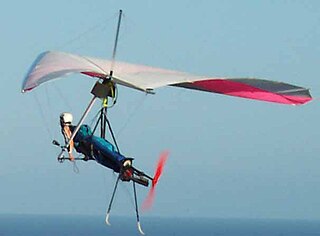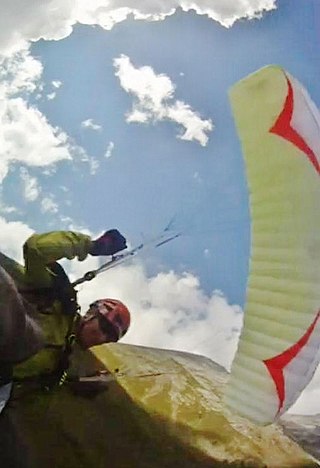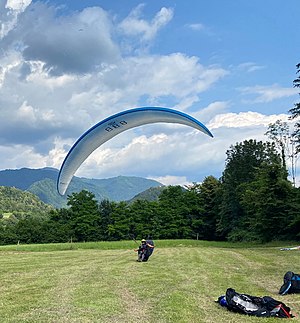
Hang gliding is an air sport or recreational activity in which a pilot flies a light, non-motorised, heavier-than-air aircraft called a hang glider. Most modern hang gliders are made of an aluminium alloy or composite frame covered with synthetic sailcloth to form a wing. Typically the pilot is in a harness suspended from the airframe, and controls the aircraft by shifting body weight in opposition to a control frame.

Paragliding is the recreational and competitive adventure sport of flying paragliders: lightweight, free-flying, foot-launched glider aircraft with no rigid primary structure. The pilot sits in a harness or in a cocoon-like 'pod' suspended below a fabric wing. Wing shape is maintained by the suspension lines, the pressure of air entering vents in the front of the wing, and the aerodynamic forces of the air flowing over the outside.
Kite types, kite mooring, and kite applications result in a variety of kite control systems. Contemporary manufacturers, kite athletes, kite pilots, scientists, and engineers are expanding the possibilities.

Powered paragliding, also known as paramotoring or PPG, is a form of ultralight aviation where the pilot wears a back-pack motor which provides enough thrust to take off using a paraglider. It can be launched in still air, and on level ground, by the pilot alone—no assistance is required.

A powered parachute, often abbreviated PPC, and also called a motorized parachute or paraplane, is a type of aircraft that consists of a parafoil with a motor and wheels.

Paramotor is the generic name for the harness and propulsive portion of a powered paraglider ("PPG"). There are two basic types of paramotors: foot launch and wheel launch.

A foot-launched powered hang glider (FLPHG), also called powered harness, nanolight, or hangmotor, is a powered hang glider harness with a motor and propeller often in pusher configuration, although some can be found in tractor configuration. An ordinary hang glider is used for its wing and control frame, and the pilot can foot-launch from a hill or from flat ground, needing a length of about a football field to get airborne, or much less if there is an oncoming breeze and no obstacles.
1997 World Air Games was an international competition of air sports, held between September 15–21, 1997 in Selçuk, Turkey, hosted by Turkish Aeronautical Association (THK). It was the first of World Air Games organized by Fédération Aéronautique Internationale once every four years. The games marked the first time more than 3000 participants from 60 countries took part in 16 different championship categories at 7 different locations at the same time.

A glider is a fixed-wing aircraft that is supported in flight by the dynamic reaction of the air against its lifting surfaces, and whose free flight does not depend on an engine. Most gliders do not have an engine, although motor-gliders have small engines for extending their flight when necessary by sustaining the altitude with some being powerful enough to take off by self-launch.

Gliding is a recreational activity and competitive air sport in which pilots fly unpowered aircraft known as gliders or sailplanes using naturally occurring currents of rising air in the atmosphere to remain airborne. The word soaring is also used for the sport.

Judy Leden, MBE is a British hang glider and paraglider pilot. She has held three world champion titles, twice in hang gliding, once in paragliding.

A glider or sailplane is a type of glider aircraft used in the leisure activity and sport of gliding. This unpowered aircraft can use naturally occurring currents of rising air in the atmosphere to gain altitude. Sailplanes are aerodynamically streamlined and so can fly a significant distance forward for a small decrease in altitude.

Speed-flying and speed-riding are advanced disciplines close to paragliding that use a small, high-performance non-rigid wing to quickly descend heights such as mountains. Speed flying and speed riding are very similar sports; speed flying is when the speed wing is foot-launched, while speed riding is a winter sport done on skis.
The Aerodyne Jumbe is a series of French single-place and two-place, paragliders that was designed by Michel Le Blanc and produced by Aerodyne Technologies of Talloires.
The Aerodyne Shaman is a series of French single-place paragliders that was designed by Michel Le Blanc and produced by Aerodyne Technologies of Talloires.

Aerodyne Technologies was a French aircraft manufacturer based in Étrembières and previously based in Talloires. The company specialized in the design and manufacture of paragliders and reserve parachutes.

Dudek Paragliders is a Polish aircraft manufacturer based near Bydgoszcz and founded by Piotr Dudek, Wojtek Domanski, and Darek Filipowicz on August 22, 1995. The company specializes in the design and manufacture of paragliders, rescue parachutes and paragliding harnesses.

Nova Performance Paragliders is an Austrian aircraft manufacturer based in Terfens. The company specializes in the design and manufacture of paragliders in the form of ready-to-fly aircraft.
Ozone Gliders Limited is an aircraft manufacturer based in Le Bar-sur-Loup, France, although it is registered in Edinburgh, Scotland. The company specializes in the design and manufacture of paragliders in the form of ready-to-fly aircraft.

The Ozone Zeno is a French single-place paraglider that was designed by the Ozone R&D Team and has been produced by Ozone Gliders of Le Bar-sur-Loup, France, since 2016.















